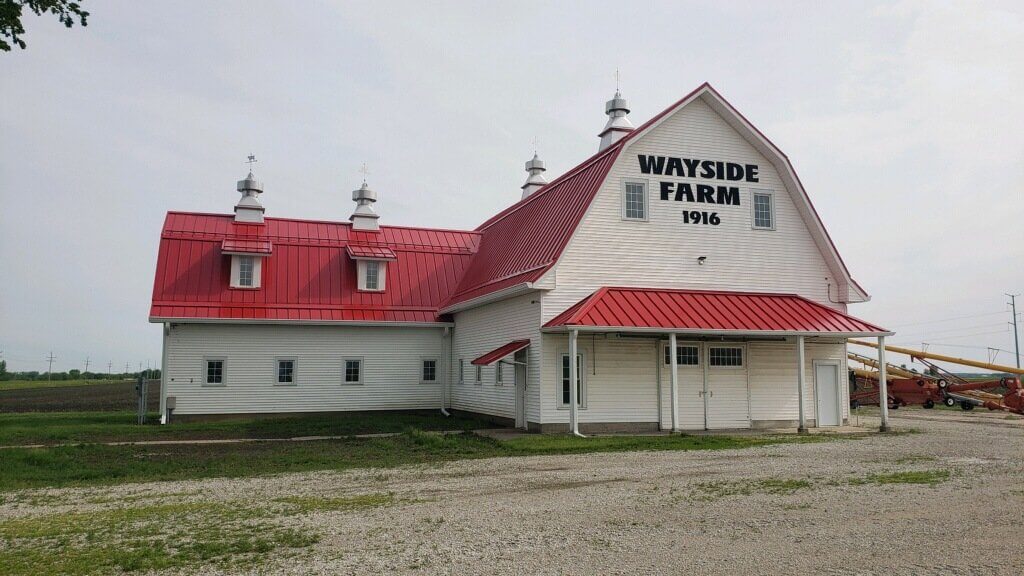The History of Wayside Farm
M.W. JOHNSON RACE TRACK & WAYSIDE FARM AND DAIRY
Assumption/Tacusah, Illinois
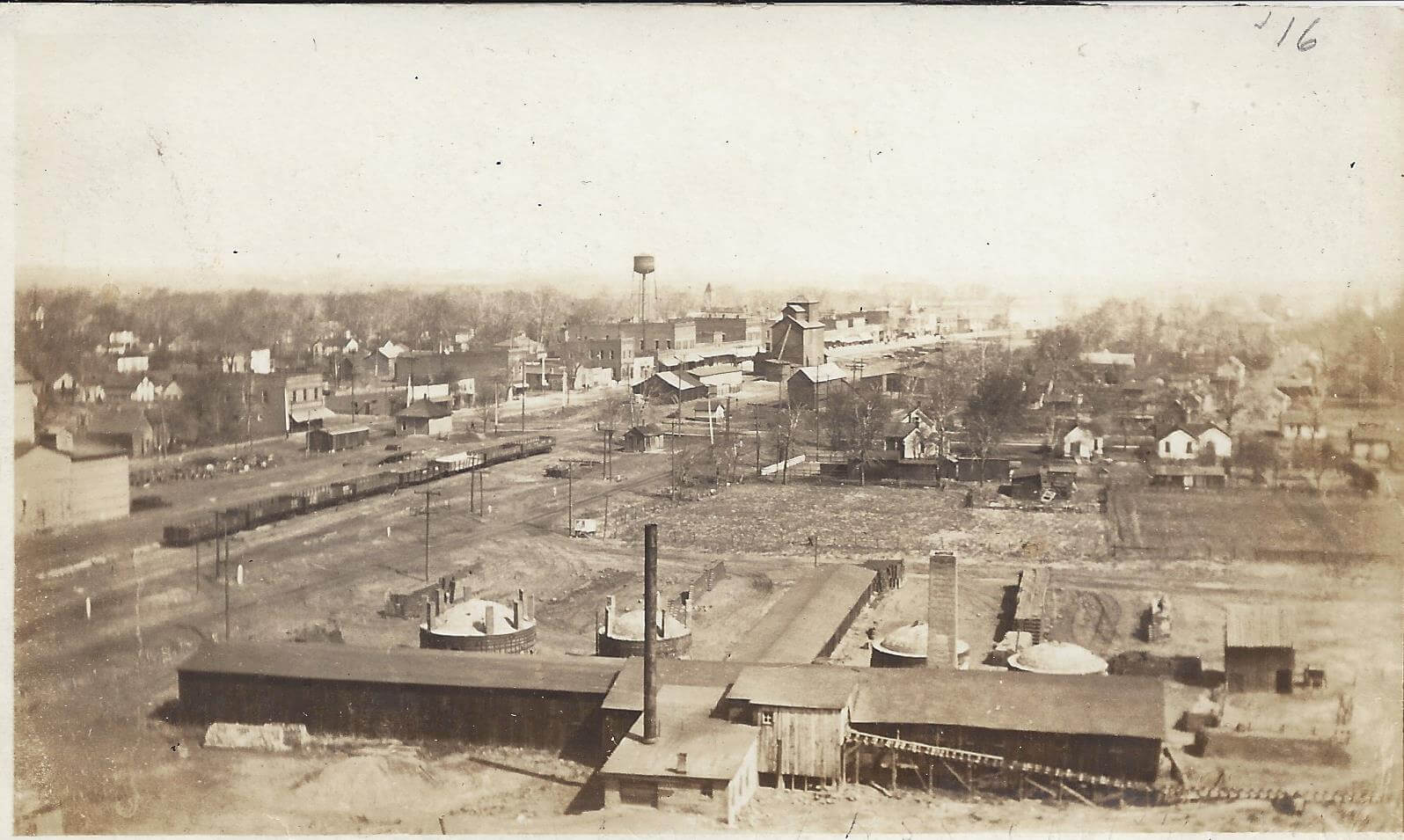
Looking at the Brick Factory from a mining slag pile looking toward town.
In writing this historical synopsis the reader is asked to note that the contents may be incomplete and there may also be unintentional inaccuracies which are characteristic of historical research to some degree. I take full responsibility and welcome corrections, clarifications and additions.
The history of the M. W. Johnson Race Track, Wayside Farm and Dairy, and settlement and development of Assumption/Tacusah, Illinois are interrelated. For much more detail on the latter the reader is directed to the document “Assumption Century of Progress 1853-1953” on file with Library Archives, University of Illinois.
We will begin in the early 1850s when the federal government conveyed land to the Illinois Central Railroad (ICR) chartered in 1851. The ICR would later be called the “Main Line of Mid-America” and also identified as the world’s longest railway. Soon after receiving the land ICR began railway construction in 1852. Land not used for the railway was transferred or sold to the public eventually becoming local communities and farmland.
As the ICR’s railway construction progressed the surrounding population also grew and local communities were created along the railway. Railway construction in the Assumption area occurred around 1853 and railway workers called the area “Tacusah”, interpreted as a native American name. Consequently, 1853 is the “birth year” of Assumption (AKA Tacusah). It should be noted that the community’s first post office was established in 1855 as the Tacusah Post Office but changed in 1858 to the Assumption Post Office; however, 1866 has also been identified as the official date of the name change.
At this point the author challenges readers to research and document the origin of the word “Tacusah”. To date this has not been done definitively. However, based on the 2000 Revised Edition of the “Atlas Of The North American Indian” the word is associated with the Potowatami tribal group. In precolonial times the area now known as Illinois was part of the Potowatami ancestral heartland. Additional evidence of Potowatami influence is provided by Assumption’s nearby sister community of Moweaqua established in 1852. Moweaqua has maintained its original native American name which is associated with Potowatami, meaning “wolf woman”. However, other native American interpretations exist such as “weeping woman” and “muddy water”. Additionally, a limited review of Illinois communities, counties, regions/areas and rivers has identified at least 17 identified as Potowatami-related (i.e., Aptakisic, Ashkum, Chebanse, Kewannee, Mettawa, Peotone, Pesotom, Pistakee, Sangamon, Shabonna and Shabbona Grove, Shobonier, Skokie, Watseka, Waukegan, Wilmette, and Winnetka). Can a more definitive and documented answer to the origin of “Tacusah” be determined?
The individual credited as the “Founder of Assumption” was Elisee Malhoit (1812-1875). He was originally French Canadian but had left Canada and settled in Assumption Parish, Louisiana. There he married, fathered children, and raised cotton. In or around 1856 he moved to the Assumption, Illinois area but left his family in Louisiana. The prospect of acquiring land from the Illinois Central Railroad may have attracted him to the area. During early growth of the area known as “Tacusah” it is believed that he used the name Assumption after a town in Canada. Because of his ties to Louisiana he later served as a Colonel in the Confederate Army during the Civil War (1861-1865). After the war he returned to Assumption and continued leadership roles as a community leader, entrepreneur, attorney, and state senator. While his family remained in Louisiana he passed away in 1875 and was buried in the cemetery complex of Greenwood, Pleasant View, and Saint Mary’s Cemeteries jointly located on the west side of Assumption.
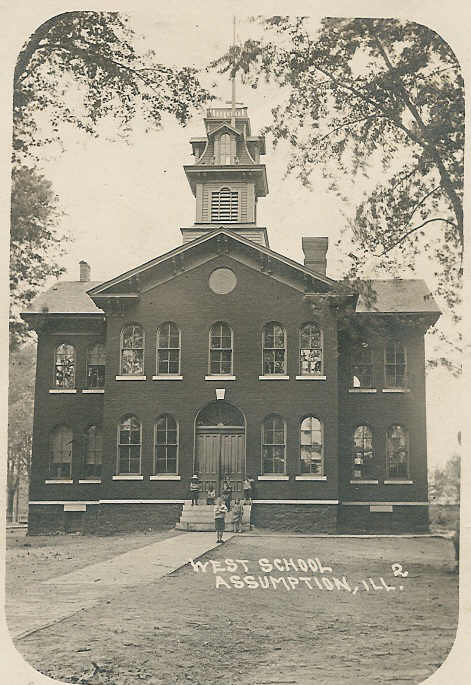
The second school in Assumption following a primitive school structure once located on Samuel Street.
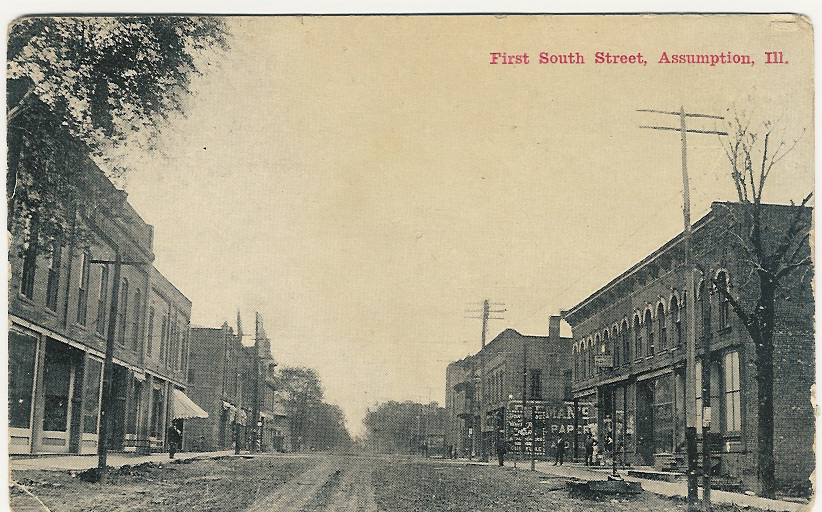
Intersection of West First South Street and Walnut Street looking east (note that the street is not bricked/paved).
Nearly a quarter century earlier, in or around 1826, Benjamin Johnson (to be noted as grandfather of Mert and Ray Johnson) immigrated to the United States from Great Britain. In 1859 he, his wife Elizabeth and eventual family of nine children settled in Christian County, Illinois (called Dane County for one year). There he acquired approximately 1000 acres of government land. Early plat maps indicate that this land was eventually passed on to family members.
In or around 1880 one of Benjamin Johnson’s children Edward transferred or sold land to his brother Walter and wife Mary. Edward’s prior ownership is documented on a 1872 plat map. Some of that land later became Wayside Farm and the location of the dairy and race track.
Prior to their land purchase Walter and Mary Johnson gave birth to two boys shortly after the Civil War, Mert W. in 1871 and Ray F. in 1873. Later these two boys would build the race track and two dairies, Maple Lawn and Wayside Farm. The boys were raised on a farm or farms north of Assumption. This included a farm located one mile directly north of Assumption on what was or was later to become Maple Lawn Farm. However it was reported in the “History of Christian County ” that they were actually born on a farm seven miles north of Assumption but how long they lived there was not identified.
Unfortunately Walter Johnson died in 1884 leaving his wife Mary with two young boys Ray 11 and Mert 13. It appears that she was very successful in raising these two boys. Both attended college and made significant contributions to Assumption, Christian County and beyond as documented elsewhere. In addition they were very successful businessmen in horse racing and selling horses, dairying and farming.
Mert and Ray were well-educated having attended Findlay College in Findlay, Ohio graduating in or around 1892. Their interest and committment to education were reflected in their large library (five book cases with five shelves per case) including but not limited to a collection of books on agriculture and other subjects, novels such as “Robinson Crusoe” and “A Tale of Two Cities”, complete volumes on the Civil War and works by such authors as Edgar Allen Poe and William Shakespeare, a set of encyclopedias and of course a very large dictionary.
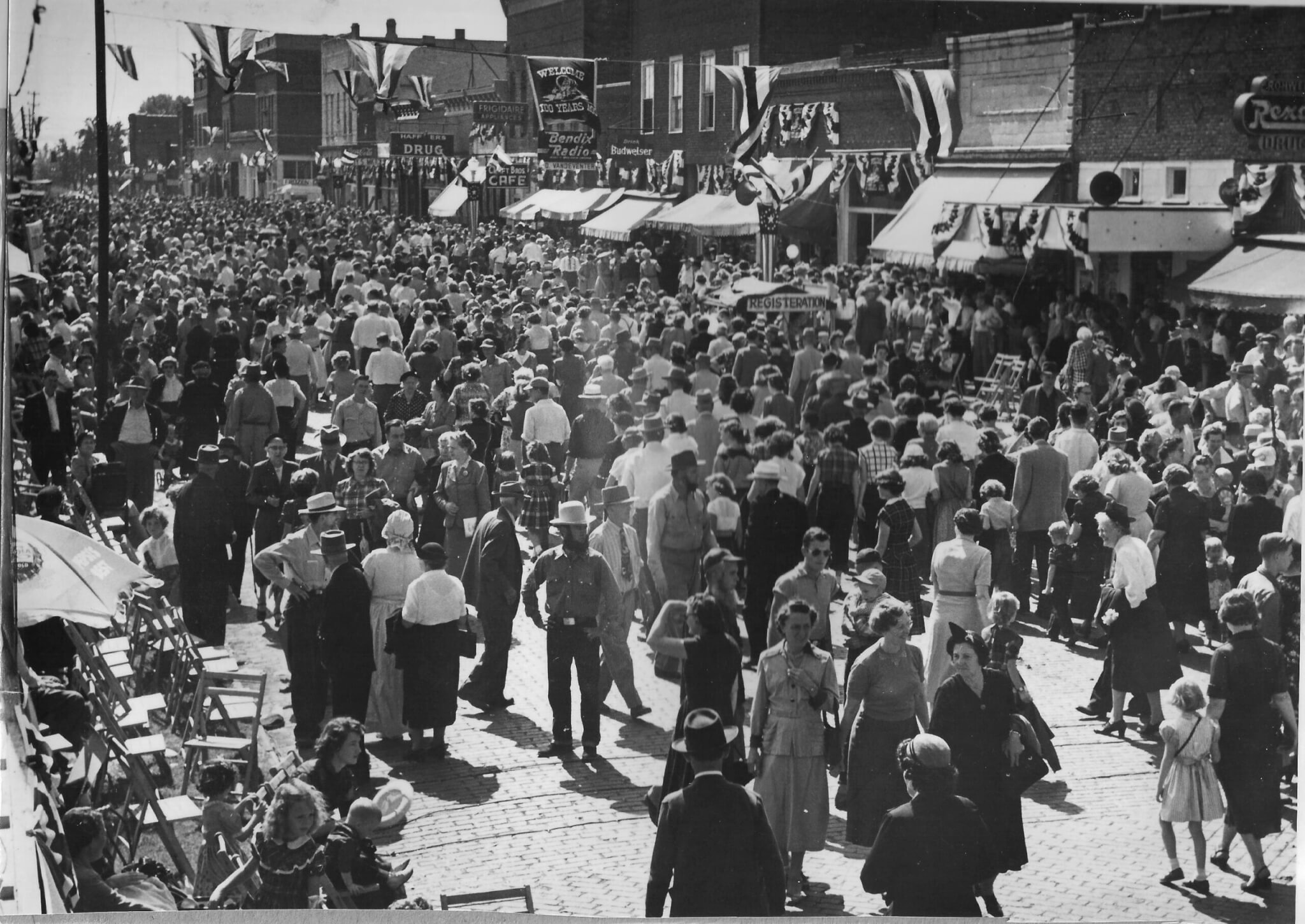
Centennial of 1953 attracted 20,000 people
In or near 1898 the M.W. Johnson Race Track was constructed for trotter racing. It should be noted that at the time Mert and Ray were only in their 20s. Mert played a major role in its creation and though known internationally for his race horses, he also dealt with draft horses (Percheron) which at that time were the primary source of power on farms – there were no tractors. At the turn of the century, 1900, the farm which included at least one horse barn and the race track was known as the “Horse Farm” only later becoming Wayside Farm and Dairy. Use of the track for trotter racing was discontinued sometime immediately before or at Ray’s death in 1915. At some time during the track’s existence it was also used for auto racing and some high school football practice. It was later plowed under for pasture and crops. Nonetheless the track’s outline is still visible on aerial photos as recent as 2010.
However Johnson’s race track was not the first race track in or near Assumption. Around 1885 another horse racing track was built and operated on the Myer’s section of land immediately west of Wayside Farm (i.e., across old Hwy 51 and the railroad). The construction date and longevity are not identified herein though it is not believed to have existed at the time of the Johnson race track.
While Mert Johnson was the primary builder and operator of the race track Ray was the primary force behind the dairy. Early documentation of a dairy built, owned and managed by Ray Johnson was published in the Daily Review Newspaper on August 9, 1915 where it noted that he began dairying in 1914. That dairy was Maple Lawn Dairy which was possibly the farm on which the boys were raised. His dairy herd numbered over 100 Guernseys as reported in the “History of Christian County” (1918). It was located one mile directly north of Assumption and less than a mile from what would become Wayside Farm Dairy.
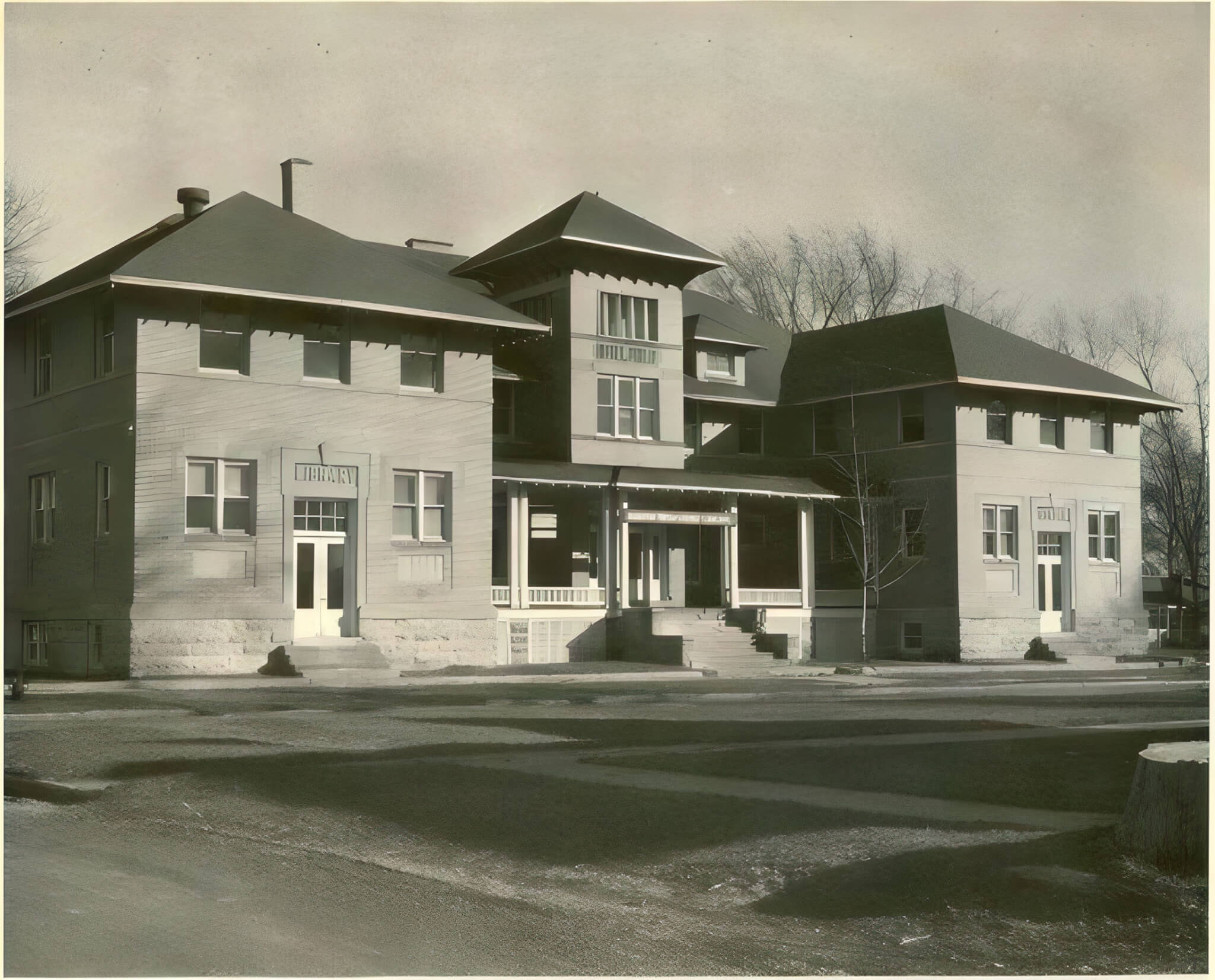
Dedicated in 1908 this building served many purposes including hotel and restaurant, community center, library and meeting place for Boy Scouts, Girl Scouts, Rotary Club, and art and ceramic classes. Building demolished in 1990.
The 1915 article provided an extensive description of the dairy as “progressive” in the development and technology of central Illinois dairies. Included in the Maple Lawn Dairy were mechanical milking machines, concrete flooring, gutters, stanchions with waterers, track feed carriers and feed troughs/mangers, managed feed program, kicking straps or kickers (used on cows’ rear legs to prevent kicking), twice daily collection of manure for use as field crop fertilizer, cleaning of the milking environment (i.e., milking personnel required to wear daily laundered white uniforms and wash hands after milking each cow, currying and udder cleaning of each cow using an antiseptic), biannual tuberculin testing, temperature control of stored milk, testing for butter content, milking twice daily (4 am and 4 pm), planned and managed breeding program and meticulous record keeping (e.g., individual milk production). Ray’s methods of dairy farming were greatly influenced by several visits to and communications with dairies in Illinois and Wisconsin a state known as a leader in dairy farming. The milking technology described above was instituted in the new dairy barn at Wayside Farm after a fire destroyed several barns in 1928 as described in following paragraphs.
It must be noted that all evidence documented herein as well as the continued existence of Wayside Farm on which the author was raised in the late 1940s, 50s and early 60s clearly indicate that the Wayside Dairy included the same technology and operation as Maple Lawn Dairy. The only recorded difference between the two dairies was the breed of milk cows – Maple Lawn milked Holsteins while Wayside Farm milked Guernseys initially though eventually switching to Holsteins.
It should also be noted that the existence of the two dairies probably overlapped during the Johnson era at least for a short period of time. While the specific date of closure and sale of Maple Lawn Farm and Dairy are not identified herein it occurred decades before the dairy at Wayside Farm closed in the mid-1960s. At that time Wayside Farm was milking less than 40 Holsteins and small dairies were forced out of business by much larger dairies for economic reasons. However Wayside Farm has remained operating and in the Wendling-VanUytven-Kiesecoms family as a grain producing farm.
In 1915 Ray and Mert owned between 1050 and 1272 acres of farm land. The imprecision is due to variation and possible inaccuracies in articles and reports as well as the inaccuracies in the actual number of farms owned or how the word “farm” was used. The 1915 newspaper article stated that Ray Johnson owned a total of five farms. However that number may have actually been the number of farm tracts or fields rather than a singular farm like Wayside Farm or Maple Lawn Farm.
The reason Ray Johnson became a dairy farmer was economic as also reported in the 1915 article. Milk production was simply more profitable than grain. During the newspaper interview Ray stated that his corn produced only 75 bushels per acre. Farmland sold for $200-$225 per acre for unimproved land at that time. Reports described land used in early farming around the Assumption area as wet or swampy. However as time passed farming practices and technology changed significantly. In 2024 corn production on Wayside Farm ranged from 220 to 265 bushels per acre and soybeans 70-80 bushels per acre while farm land prices were approaching an average of $15,000 per acre.
At this point the transfer of Johnson land ownership should be clarified. After her husband William died in 1884 Mary Johnson became owner. At that time both Ray and Mert were very young, 11 and 13, respectively. It is assumed that assistance with the farm and land they owned was provided by William’s brothers and sisters who resided in the area. In 1901 Mary deeded the land to her oldest son Mert who passed away in 1915. Ray was then designated as “administrator” followed by full ownership in 1924 a year after his mother passed away.
On July 15, 1928 a fire broke out on Wayside Farm destroying a horse barn, dairy barn, silo, blacksmith shop, chicken house and an undetermined number of hogs. One of the barns included a photograph gallery containing pictures of Mert Johnson’s horses and race track and a well furnished office containing quarter-sawed oak furnishings, leather upholstered chairs and a large quantity of records on registered horses and cattle. As further reported in the Decatur Review, July 16, 1928 the suspected cause of the fire was an electrical wire.
It is believed that the dairy barn which burned in the above fire was a horse barn from previous years and converted to a dairy sometime between Mert’s death and 1928. Ray Johnson promised to rebuild immediately and began doing so completing the new Wayside Farm Dairy Barn in 1929 as it now stands (i.e., but with a new red metal roof as of 2022, and white siding in 2023). A 1928-29 picture of its’ framing can be found in the Wayside Farm and Race Track History binder compiled by the author of this document. The barn was well built as indicated by its current condition and nearly 100 year lifespan of the roof.
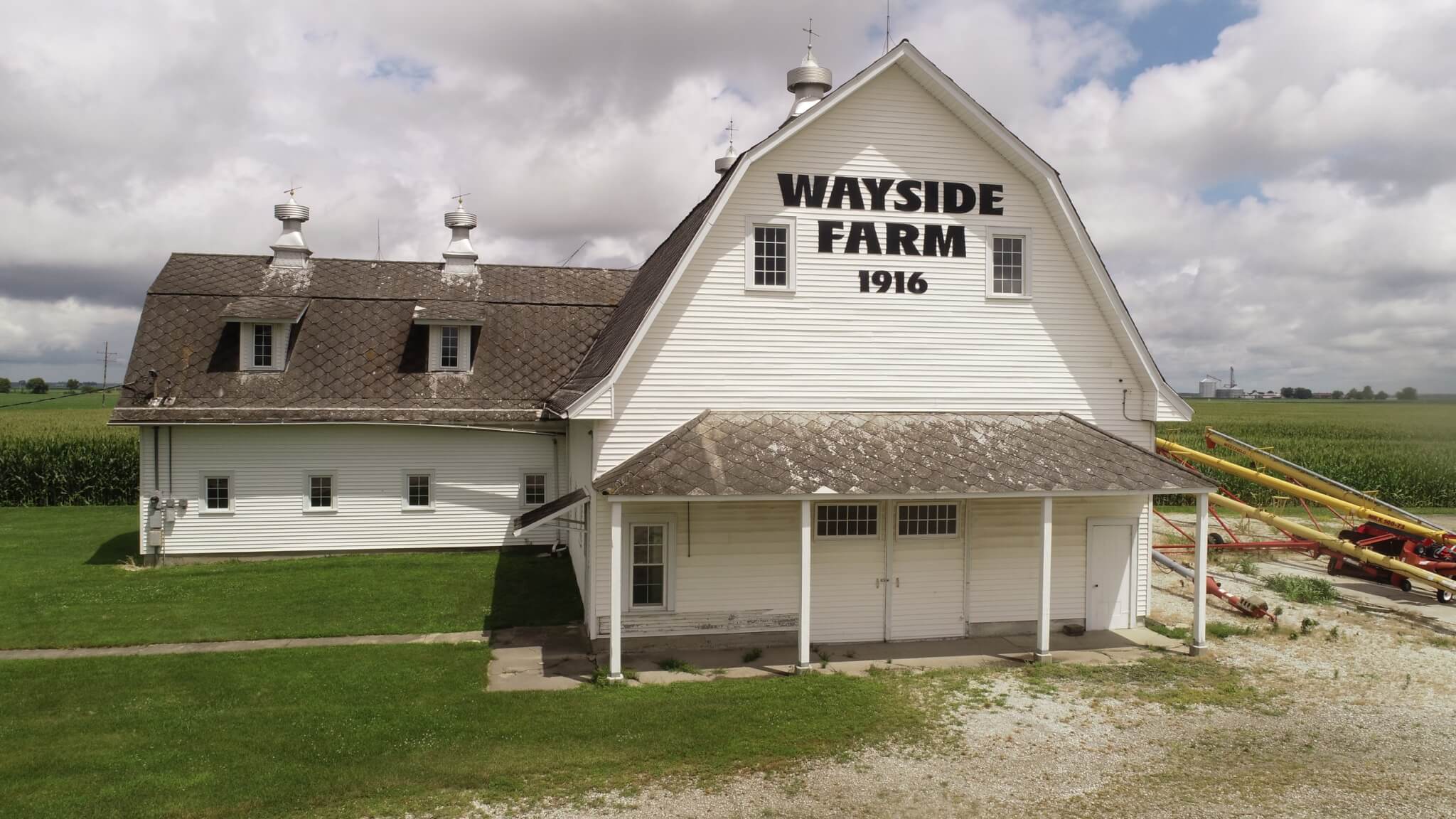
Rebuilt in 1929 following devastating fire. Quality of early construction evident by addition of new red metal roof in 2022, nearly 100 years after rebuild.
As mentioned earlier, in 1915 Ray Johnson owned well over 1000 acres of farm land, a large house, several barns and related buildings, and livestock including dairy cattle, beef cattle, hogs, and horses. Additional farm animals included chickens and turkeys as noted in early photographs of Wayside Farm. However by 1935 Ray’s assets including Wayside Farm had diminished significantly for two reasons. One was the Great Depression which began in 1929 and the second was Ray Johnson’s divorce from his wife Gertrude in 1931.
On December 14, 1935 just six years after the new dairy barn had been completed Ray Johnson died from “several weeks of illness caused by a complications of diseases” at his home Wayside Farm. During the last few years of his life he was restricted to a wheelchair for a cause not identified. Between 1920 and 1935 Bertha VanUytven the grandmother of this document’s author worked and later cared for Ray. For that he willed her Wayside Farm which at that time included 133 acres, furnished farm house including a large library, dairy barn, silo, blacksmith shop, other buildings (unknown), dairy cattle, beef cattle, hogs and other farm animals.
From that Bertha Verhaegen Kiesecoms VanUytven raised two children, Robert Kiesecoms and Vivian Kiesecoms Wendling. By 2008 and following decades of very hard work and strong commitment to farming by these three individuals the farm had grown to 835 acres with grain production the primary output. In 2019, eleven years later and just over 100 years from when the farm was officially registered in 1916 as “Wayside Farm”, it once again attained its original size of nearly 1100 acres with the addition of 260 acres.
That and so much of what I accomplished in life would not have been possible without my “Grandma”, “Uncle Bob” and “Mom”. I am truly and forever so grateful! Consequently, in 2013 the “Wendling VanUytven Kiesecoms” Foundation was created in their memory.
Bob Wendling
February 2, 2022
May 14, 2024
June 23, 2025
SOURCES OF INFORMATION
Atlas Of The North American Indian, 2000 Revised Edition by Carl Waldman.
Assumption Century of Progress (1853-1953), University of Illinois Library Archives.
Christian County Plat Maps, 1872 and 1891.
Decatur Review Newspaper, Aug. 9, 1915.
Decatur Review Newspaper, Jul. 16, 1928.
Family Documents and Discussions with Family Members over 50 Years, 1960-2013.
Historical Encyclopedia of Illinois, History of Christian County, Vol. II, 1918.
Prairie State Tribune Newspaper, Nov. 2, 1934.
Prairie State Tribune Newspaper, Dec. 20, 1935.
US Bank Farm, Ranch and Timber Management Department, Springfield, IL 2025

